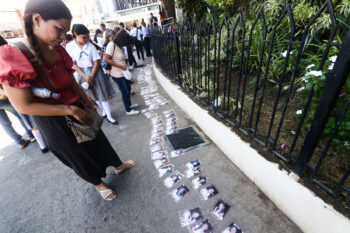IV. State of Moro Problem: Enigmatic
GENERAL SANTOS CITY (MindaNews/26 October)– Unacceptable demands and the policy of crime and punishment precluded negotiation; military action prevailed and wrecked havoc. This is one view of the “20 – day Zaboanga war”. In retrospect, the conflict of “unacceptable demands and the crime and punishment policy” has been a recurrent reality in the Moro or Mindanao Problem (henceforth: “Problem”). And whenever negotiation failed, military action prevailed.
Just curious: What is the state of the Moro or Mindanao Problem? Is the Zamboanga City “standoff” or “siege” the last consequence of that state? Or, is it just the latest episode of the many more episodes to come – the water under the bridge that keeps on flowing back?
Overview of the Problem
At the heart of the Problem is the quest of the Moro leaders to regain their lost sovereignty, to reclaim their ancestral domain and to assert their right to self-determination in running their political, economic and social affairs. The Moros fought and compromised to keep their sovereignty during the 300-year Spanish colonization; lost it and petitioned for its return during the 35-year American rule; and rose in rebellion to secede in the 1970s. Since 1976, they have been negotiating for autonomy within the full meaning of their quest.
Essentially, the demands in the petitions of the Moro leaders to the Congress and President of the United States of America in the early 1920s and in 1934 were among the demands of the Moro secessionists in the 1970s. With the Organization of Islamic Conference (now: Cooperation) wielding the cudgel for the Moros, the Philippine government in the 1970s could not ignore, as the American governments did, the Moro demands. It had to negotiate; succeeding governments have continued the negotiations.
At the behest of the OIC, the MNLF then still intact under Chairman Nur Misuari dropped their demand for independence and negotiated for autonomy in Tripoli in December 1976. The GRP (Government of the Philippines)-MNLF Agreement was signed – its substantive provisions to be finalized later. This, however, was never implemented bilaterally until the signing of the Jakarta Accord or the GRP-MNLF 1996 Final Peace Agreement, “the full implementation of the Tripoli Agreement”.
In 1977, however, the New MNLF (later, the MILF) under Salamat Hashim and the MNLF Reformist Group (now defunct) under Dimasangkay Pundato broke away from Misuari. They all demanded the “full implementation of the Tripoli Agreement” but they separately pursued their demands. While President Ferdinand E. Marcos and the succeeding Philippine presidents gave Misuari the primary attention, Marcos refused to negotiate until the factions could reunite.
In 1996, after signing the GRP-MNLF Final Peace Agreement, President Fidel V. Ramos — known for his “win-win solution” to troubles — negotiated a separate peace with the MILF. Since the just signed Agreement with the MNLF and the just started negotiation with the MILF involved the same Problem with the same people in the same area of autonomy defined in the Tripoli Agreement, that same Problem became “two-in-one” — MNLF-centered and MILF-centered. The two have splintered after 1996; so the “centers” have become “diffused”.
Re-stated: The Problem now is two-centered and diffused. In the main solution of the Problem – the establishment of the Moro autonomy – the government has to deal with two centers. With the emergence of the Abu Sayyaf in the mid-1990s and of the BIFF (Bangsamoro Islamic Freedom Fighters, a splinter of the MILF recently), the security problem is more diffused. The state of the Problem is “volatile”; Ramos’ “win-win” can turn into “loss-loss”.
Tripoli Agreement and After
The solution to the Problem is “Part One” of the Tripoli Agreement: “The establishment of Autonomy in the Southern Philippines within the realm of the sovereignty and territorial integrity of the Republic of the Philippines”. The implementation is in Parts Two and Three.
Part Two which delineates the area of autonomy – thirteen provinces and their included cities – was said to be final; but in reality not. To the Philippine government, the finality is determined by a plebiscite according to its interpretation of Paragraph 16 of Part Three.
Part Three has (A) ten substantive provisions – Paragraphs 1 to 10 — on which to entrench the autonomous region; (B) one provision – Paragraph 12 — on the declaration and implementation of a “ceasefire”; (C) one provision – Paragraphs 11 – on a mixed-committee meeting to finalize the substantive provisions that were to be “discussed”, “fixed” or “determined later”; (D) three provisions – Paragraphs 13, 14 and 15 – on the initialing and signing of the Final Agreement after the mixed-committee meeting and the formation of a Provisional Government to establish the Autonomous Government.
The Philippine Government was tasked to implement the Agreement. Paragraph 16: “The Government of the Philippines shall take all necessary constitutional processes for the implementation of the entire Agreement.” Later, this frustrated the MNLF and the OIC; to the Philippine government, Part Two and the substantive provisions of Part Three must be in accordance with the Philippine Constitution.
A 90-day peace talk in preparation for the full implementation of the Tripoli Agreement was held by President Corazon C. Aquino’ government in 1987; it bogged down because of Paragraph 16. The 1996 FPA, the full implementation of the Tripoli Agreement and according to the Philippine Constitution, is a paradox. Its full implementation is the heart of the MNLF-centered Problem. The truth is: Misuari did not want the Tripoli Agreement to be implemented according to the Philippine Constitution. But stuck with Paragraph 16, its full implementation must be so.
Essentially, Paragraph 16 has become an integral part of the Philippine policy in negotiating peace with the Moros. In the Government-MILF negotiation, the Constitution had been a gaping wide obstacle until bridged with a compromise: The Bangsamoro Transition Commission, in drafting the Bangsamoro Basic Law can propose amendments to the Constitution if necessary (Framework Agreement on Bangsamoro, VII.4.a).
MNLF-Centered Problem
The MNLF-centered Problem hangs on the full implementation of the 1996 FPA. What a great contradiction! A fully implementing agreement not fully implemented? A solution that does not solve only complicates the problem. As a solution, the 1996 FPA was faulty.
Much of the fault was Misuari’s; but he would not recognized this and has been fully blaming the government – not the Ramos government for co-opting him and his MNLF but the Arroyo government five years later and now the Aquino III’s for not fully implementing the 1996 FPA.
What were his faults?
1. He allowed himself and his panel to be co-opted.
2. He signed an agreement affirming Paragraph 16: “…Any conflict in the interpretation of this Agreement shall be resolved in the light of the Philippine Constitution and existing laws (Last sentence, Paragraph 153, FPA).”
3. He signed an agreement not requiring its full use in amending or repealing R.A. 6734 but giving the Congress the discretion – “The bill (to amend or repeal) shall include the pertinent provisions of the Final Peace Agreement … (FPA. 2.a).” Isn’t that ironic? The Congress was given the discretion to “include” only the “pertinent” provisions then accuse it of “not fully implementing”!
4. He negotiated and signed an agreement which was almost completely a rehash of R.A. 6734. By that he virtually accepted the ARMM and its Organic Act which he had vehemently rejected. That, too, validated the false claim that the 1996 FPA created the ARMM – making lie a truth.
5. As governor of the ARMM and chairman of the MNLF, he did not monitor the amendment of R.A. 6734; nor did he form a panel to do the monitoring in the Congress.
Very much of the MNLF-centered Problem can be traced to these faults. Yet, while the OIC, in not only one OIC-CFM resolution, had affirmed the substantial implementation of the 1996 FPA and the Philippine government had insisted in its full implementation, the GRP-MNLF-OIC Tripartite Review for the full implementation of the 1996 FPA was constituted in November 2007. Believe it! The FPA was negotiated in three years; the review of its full implementation has not been completed in six years and is still going on.
In early 2011, The Tripartite Review officially recommended 42 amendments to R.A. 9054 to fully implement the 1996 FPA. Early this year, Misuari disapproved the filing of the proposed bill embodying the 42 amendments until the resolution of three new issues: (1) “Plebiscite on the territory [according to Part Two of the Tripoli Agreement]”: (2) “Provisional government [according to Part Three, Paragraph 15 of the Tripoli Agreement]”; and, (3) Sharing on strategic minerals”. The first two are issues already decided – the decision Misuari would not accept.
Queer Position
The MNLF, under Misuari (1996-2001) and Parouk Hussin (2001-2005) as governors, had been given the political reins of the ARMM. Losing the patronage of Malacanang, Hussin lost in the 2005 ARMM election his re-election bid – the MNLF totally wiped out except for retaining one seat in the Regional Legislative Assembly. They followed up at the OIC their earlier complaint that the FPA had not been fully implemented.
The MNLF position is queer. The review must be for the interest of the ARMM. But being out of the ARMM government, they can no longer represent the ARMM; they must be representing the interest of the MNLF. The Review can have the FPA “fully implemented” only by proposing amendments R.A. 9054 to the Congress. But only the ARMM government can implement the amendments, not the MNLF. In the Review, the government panel is composed of representatives from the ARMM.
Has the MNLF been reviewing the implementation of the FPA with ARMM representatives to turn the clock back to 1976? In his two new demands, Misuari meant by “full implementation” the expansion of the ARMM according to Part Two of the Tripoli Agreement and he wanted the ARMM re-started with a “provisional government” as agreed 57 years back.
Evidently, he had become impatient and desperate in seeing the Government-MILF peace negotiation overcome the Review. The Zamboanga City “20-day war” was the latest indication that Misuari had reverted to the revolutionary mode and given notice of the remaining MNLF force. The MNLF-centered Problem is centered on Misuari.
MILF-Centered Problem
President Ramos must have seen the Problem as two-centered; he knew satisfying one center would not satisfy the other center. He must also have known that satisfying both centers would not solve the Problem until the two could be reconciled. Did he have in mind how to? Whatever his “win-win” approach was he kept to himself.
The MILF-centered Problem is now seen as the Problem and the establishment of Bangsamoro as agreed between the Government and the MILF as the Solution. The failure of the 10-year MNLF rule of the ARMM to show the difference helped turn the focus of the Government and most of the Moro people to the MILF-centered Problem.
As seen in the 16-year Government-MILF negotiation – and shown in the aborted Memorandum of Agreement on |Ancestral Domain (MOA-AD) and in the FAB soon to be completed into the GPH-MILF Comprehensive Agreement – MILF has a better grasp of the Moro problems than do Misuari and the MNLF and better prepared to negotiate with the proper solutions to the Moro problems.
The negotiation to end the Problem has generated international support. The OIC which, in much of the 16 years since 1997, had been visibly indifferent or lukewarm to the GRP (GPH)-MILF negotiation, has recognized the FAB and its November 17, 2012 OIC-CFM Resolution No. 2/39-MM urged the Philippine Government to link the FAB and the FPA. This recognition is also reminder that in satisfying the MILF-centered Problem, the MNLF-centered must not be ignored.
Much hope, effort and good will – local, national and international – abound for the solution of the MILF-centered Problem. However, many obstacles lie in the way. Bangsamoro will be entrenched; that is foreseen. Will the euphoria be different from that at the signing of the FPA on September 2, 1996?
Government’s Role
The Philippines holds the solution to the Problem, having agreed to the: “The establishment of Autonomy in the Southern Philippines within the realm of the sovereignty and territorial integrity of the Republic of the Philippines. (First Part, Tripoli Agreement)”. “Sovereignty” and “territorial integrity” are defined in the Philippine Constitution. The “Autonomy” can either be constricted by the strict definitions of the two terms in the Constitution or it can be liberalized by amending the definitions to the full extent of their democratic parameters.
Since 1976, Autonomy, as the “agreed” solution to the Problem, has bogged down under the strict provisions of the Constitution and existing laws. On hindsight, the Problem could not have existed had the Americans and succeeding Filipino rules granted self-government to the Moros.
What has stymied Autonomy since 1976?
In Jakarta, Misuari insisted – with threats to walk out – to negotiate only within the letter and spirit of the Tripoli Agreement. Ramos and his two leading negotiators – fellow generals Manuel Yan and Eduardo Ermita – were unfazed. They made Misuari feel good and important. In three years, the FPA was signed; accepting the ARMM governorship, Misuari with the MNLF pledged loyalty to the Philippine flag and sang the national anthem. The negotiation was as Misuari had insisted — with Paragraph 16 of Part Three as the defining “letter and spirit”.
It’s to be wondered how the Ramos-Yan-Ermita Triumvirate co-opted Misuari. According to MILF, as revealed in its website, Luwaran.com, the Ramos government used what may be called the “Paikutin natin sila (Turn the table on or fool them)” stratagem. [See: Luwaran.com. July 7, 2008: In GMANews.TV, July 7, 2008: MILF hits Ermita for going back to ‘old song’ on peace process; in MindaNews, July 7, 2008: MILF: Ermita back to ‘old song’. Luwaran.com. June 20, 2008: In MindaNews, June 20, 2008: MILF describes legal study results still part of its ‘paikut’ scheme; Google “Paikutin natin sila – Ermita”]
The 1996 FPA was not the “full” solution to the Problem, as intended to be. In August 2011, President Aquino III declared ARMM “a failed experiment”, meaning, a failed Autonomy.
On Day One of the GRP-MILF negotiation in 1997, MILF made it clear they did not recognize the Philippine Constitution and would negotiate outside of it. In the MOA-AD of 2008, through “language engineering” they came up with an agreement that would require the amendment of the Constitution; yet, it did not mention the word even once. After the abortion of the MOA-AD, the word “Constitution” was no longer anathema.
The FAB of 2012 will establish Bangsamoro with features that will need the amendment of the Constitution; it has a specific provision allowing proposals to amend the Constitution “when necessary”. Yet, Government, in the negotiations of the Annexes to flesh out the FAB, wants, as much as possible, to stick strictly to the existing Constitution lest the BBL draft embodying the agreements for enactment into the organic law of Bangsamoro might be rejected by the Congress and the public.
The Constitution has stymied the Autonomy. On the part of Misuari and MNLF, the Autonomy they had wanted was sealed by Paragraph 16. On the part of MILF, Government has agreed to entrench the Bangsamoro and if necessary amend the Constitution, providing so in the FAB. But, for a year now since the signing of the FAB, why has Government been trying to strictly adhere to the Constitution? Is it reluctant to use its political will to convince the Congress and the public to amend the Constitution, or is it resorting in a subtle way to “paikutin natin sila”?
Enigmatic
Looking at the Problem from its two centers and the conduct of Government, the state of the Problem is still anxiety behind optimism. What the Zamboanga City “20-day war” reveal is that anything can happen.
The MNLF was considered a “spent force”. Obviously, Misuari and his MNLF had been taken lightly. But, look at the damage a “spent force” has caused! Certainly, MILF is not a “spent force”. And so is the obviously underrated BIFF. Of course, MILF has assured all against the use of force. However, what if the assurance misconstrued and taken for granted?
Just curious! How soon will the GPH-MILF Comprehensive Agreement be signed? Can the 1996 FPA be satisfactorily “linked” with it? Will the Bangsamoro that will solve the Bangsamoro Problem, as originally proposed – not just any Bangsamoro – be entrenched by President Aquino III? Will the Moro leaders unite behind this Bangsamoro?
Until these happen, the Problem will remain enigmatic.
[“Comment” is Mr. Patricio P. Diaz’ column for MindaViews, the opinion section of MindaNews. Mr. Diaz is the recipient of a “Lifetime Achievement Award” from the Titus Brandsma for his “commitment to education and public information to Mindanawons as Journalist, Educator and Peace Advocate.” You may e-mail your comments to patpdiazgsc@yahoo.com]







